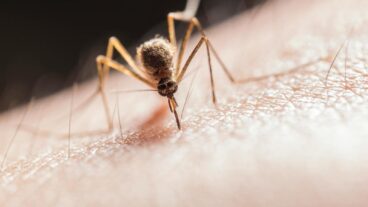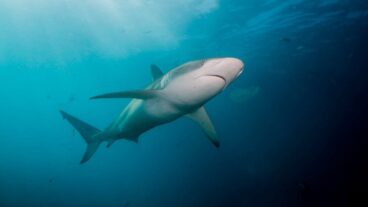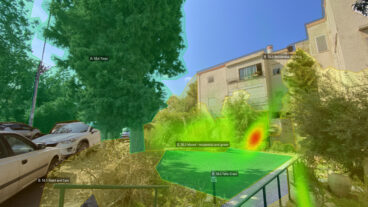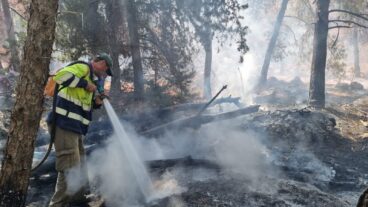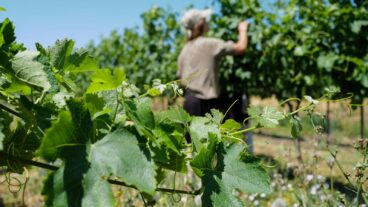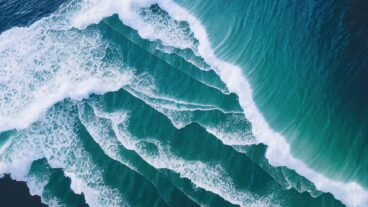Professor Daniel Weihs – I’ve been studying nature for many years to learn about all kinds of phenomena of fauna and flora that can be applied to everyday human life.
Who would think to use dandelion seeds as a model for a counter-terror tool? Or base a missile defense system on a type of fish?
Daniel Weihs would.
A naturalist-engineer, Prof. Weihs is a broad-based scientist, a species almost as endangered as the animals he strives to protect. An aerospace engineer who has been involved in some of Israel’s most critical and prestigious defense projects, Weihs is as well-versed in fluid mechanics, thermodynamics and systems engineering, as he is in bird and fish behavior, often the inspiration for his highly technical work.
“I’ve been studying nature for many years to learn about all kinds of phenomena of fauna and flora that can be applied to everyday human life,” he told ISRAEL21c.
Throughout his varied research career, Weihs has used nature as a model. “Whatever exists in nature now, has been through an optimization process much more rigorous than any we can do,” he says. “In nature, it’s simple: If you don’t succeed, you get eaten up. There’s a lesson in that.”
And Weihs has helped keep Israel safe from its own predators.
In a recent project conceived at the Technion, and now being developed with RAFAEL Israel Armaments Authority, Weihs and colleagues from the Faculties of Mechanical Engineering and Mathematics used dandelion seeds as models for counter-terror tools. Their brainchild, tiny Unmanned Airborne Vehicles (UAVs) rapidly and efficiently detect the presence of biological and chemical agents. These nano-drones, less than one centimeter in length, change color when they come in contact with different gases.
Based not on sophisticated circuitry or electronics, but on Mother Nature, these unpowered, stable windborne gliders are made of thin plastic fibers. Developed in the Technion?s Faculty of Mechanical Engineering, the fibers are less than one one-thousandth of a millimeter wide. Resembling dandelion seeds, they look like inverted umbrellas, with comb-like sides. The next step in this project, says Weihs, is making powered millimeter-sized drones that can move on their own. Or, if you will, moving from the plant world to that of insects.
As a by-product of saving an endangered bird, the kestrel, Weihs pioneered a device for flight control. Researching the survival of kestrels in the face of shrinking habitat, Weihs observed that the birds had an unusual ability to stabilize their heads while in flight or hovering.
“This allows them to identify prey and then compute a precise trajectory for catching it,” says Weihs, who went on to investigate head stabilization among kestrels, and other raptors like kingfishers and herons. Ultimately, he applied his findings to the development of new control mechanisms for aircraft.
In another project, conducted with Israel Military Industries (IMI), Weihs investigated whether missile warheads should be built in a non-circular shape for certain types of attack missions.
“I looked at the boxfish family, which has a body shape that stabilizes its motion by creating vortices similar to those of delta winged aircraft, like the Concorde,” says Weihs. Today, IMI is incorporating ideas based on this boxfish study, in a new generation of non-round missiles, capable of drawing attacking missiles off target.
This is a small sample of close to 100 research projects conducted by Weihs, which bear names like: Escape swimming of lobsters; Spoonbill foraging motions; and Hydromechanics of fish schooling. Many have been applied to the development of concrete – and often crucial – devices. Asked to name which of these efforts has given him the most pride, Weihs laughs.
“That’s an impossible question – like asking a parent which of his children he loves most,” he says, beaming at the thought of his own three grown children, two boys and a girl, all Technion-educated engineers. “But if I really had to answer, I’d point to my latest work on dolphins.”
In recent research Weihs explained why dolphin-friendly tuna fishing has still not led to a recovery of dolphin populations in the Eastern tropical Pacific Ocean. Through mathematical modeling, Weihs shed light on the phenomenon of ‘drafting’, in which dolphin calves position themselves close to their mothers’ sides, in an attempt to reduce the effort needed to swim. He suggested that fleeing from fishing vessels could easily disrupt the positioning of mother-calf pairs, permanently separating them.
Weihs’s findings on dolphins may help in evaluating the proposed relaxation of the ‘Dolphin-Safe’ definition. Such a move would help fishermen find better ways to set their nets around dolphin schools so that no dolphins would be killed or seriously injured. Weihs’s results suggest that relying on fishermen’s observations of injuries to dolphins would underestimate the damage inflicted on their populations. Highly original, this work has received media coverage worldwide.
Perhaps Weihs’s rather unconventional approaches can be attributed to his own unusual beginnings. Born in Gweilin, China, in 1942, Weihs was the only child of Austrian parents who fled Nazi-occupied Vienna. While most of the Jewish refugees in China lived in what Weihs describes as “tough ghetto conditions” in Japanese-occupied Shanghai, Weihs’s father, a doctor, was able to find work in the ‘free China’ city of Gweilin. Cared for by a Chinese nanny, and first schooled in a British Anglican mission, Weihs immigrated to Israel with his family in 1949.
After completing his undergraduate and graduate studies at the Technion, Weihs spent two and a half years at the University of Cambridge, England. Upon his return to Israel in the early 1970s, Weihs joined the Technion’s Faculty of Aerospace. At the same time, he worked with Israel Aircraft Industries on development of the Kfir fighter plane, which became a mainstay of the Israel Air Force, and was used by the US Navy and Maine Corps for air combat training. With RAFAEL, he helped develop reactive armor for anti-tank protection, which has been adopted by armies throughout the world. A full professor at the Technion since 1983, he is one of only seven to hold the title of Distinguished Professor in Israel.
Maintaining an international profile, Weihs has carried out research at Atlas Copco in Switzerland; England’s Ministry of Agriculture, Fisheries and Food; and at the NASA Ames Center in California.
Asked what’s next, Weihs is circumspect. “As long as I remember, I have been attracted by all things connected with flight and swimming,” he says. “I don’t expect that to change – I’ll never be grounded.”




